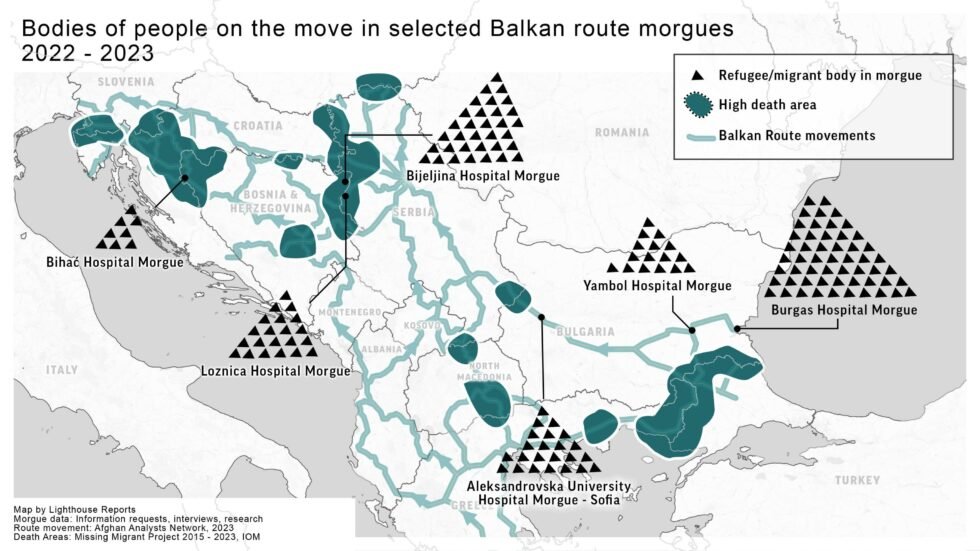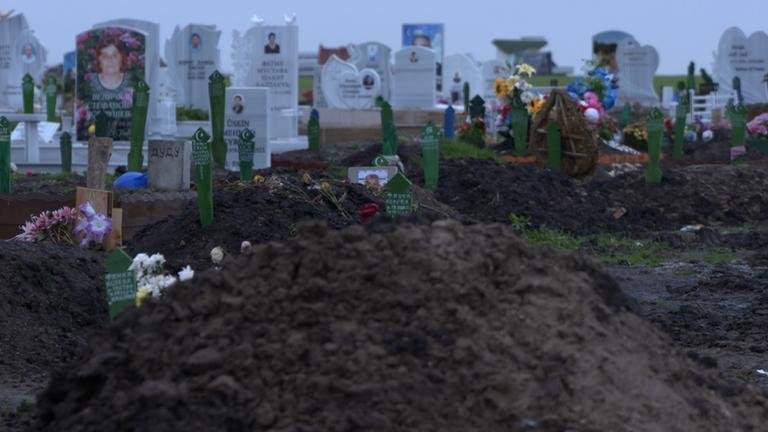Migrants traveling along the Balkan route from Turkey through southeastern European countries towards Germany is not a particularly new phenomenon. However, 2022 marked the greatest number of crossings since 2015, according to figures from the European Border Agency Frontex.
Also in recent months, after a slight decline in the first half of this year, many countries along the Balkan route have reported an increase in the number of migrants they have detained after trying to cross their borders without papers.
The IOM’s Missing Migrants project has recorded just 44 deaths since the beginning of 2023 in the Western Balkans, but investigators believe that the actual number is much greater.
In the eight years since 2015, as the investigative journalistic outlet Lighthouse Reports notes in its latest investigation “Europe’s Nameless Dead,” published on December 1, the borders have significantly changed. Many of the countries along the route, including Hungary, Slovenia, Slovakia, Bulgaria, Bosnia and Serbia, have erected fences, increased patrols and generally made crossings more difficult.
Organizations that work with migrants believe that the barriers don’t deter many from attempting the crossing, it just slows up their journeys and pushes them to try ever more dangerous routes. In some cases, these routes lead through mined territory, through dense forests, across rivers with strong currents, or high mountain ranges.

‘Buried without a trace’
The length of journeys and difficulty of the terrain take a toll on most, even on the fittest of migrants. Extremes of weather, both excessive heat in the summer and cold in the winter also exacerbate the problems many migrants face on these journeys.
It is difficult to know exactly how many migrants may have died along the Balkan route. There is no official data collected along the entire route, and since many migrants on the route are unregistered in the countries where they might be traveling, no one may know if those who entered a country end up leaving again to travel onwards.
However, Lighthouse Reports, in conjunction with the Radio Free Europe / Radio Liberty (RFE/RL), the German news magazine Der Spiegel, the German public broadcaster ARD, the iNews newspaper, We are Solomon, a non-profit based news source based in Greece, as well as academics from Aston, Liverpool and Nottingham Universities in the UK, have attempted to measure the scale of migrant deaths at the borders of the route spanning Bulgaria, Serbia and Bosnia.
Their investigation found that the “hostility people face at the borders of Europe in life continues into death. State authorities make little to no effort to identify dead migrants or inform their families, while individual doctors, NGO workers and activists do what they can to fill in the gaps. Unidentified bodies end up piled in morgues or buried without a trace.”
Lighthouse Reports acknowledges that “some bodies will never be found” and so it was “clear from the outset that it would be impossible to get comprehensive numbers on migrant deaths … particularly when people have drowned in rivers or died deep in forests.”

For their investigation, the teams requested data from police departments, prosecutors’ offices, courts and morgues. Through this process, they say, they managed to “obtain data on the number of bodies known or presumed to be migrants received by six morgues near the borders along the Bulgaria-Serbia-Bosnia route.”
They found that since the beginning of 2022, 155 such cases had been reported across the six facilities — the majority (92) dying in 2023.
Searching for Majd
In many cases, the families of these migrants only know that their loved ones are missing. Authorities often do not gather enough information, or cannot gather enough information to be able to properly trace these people.
The investigative teams found WhatsApp groups, Facebook pages and other social media channels with posts purporting to be from families desperately searching for loved ones.
RFE/RL followed the story of Husam Adin Bibars, a Syrian man, who lost his son, Majd Addin Bibars, on the route earlier this year. His story was reported by all the media outlets.

Husam Bibars, now living in Denmark, believes his son went missing in Bulgaria on his way to try and reach Western Europe in September. Bibars managed to find the smugglers who had sold Majd the journey. They told him they had left him just a kilometer from a main road in Bulgaria. Bibars then engaged a lawyer, in the hope that Majd had been caught by border police and taken into Turkish detention. He also published his photo on WhatsApp and Facebook groups.
‘Lifeless body…died of thirst, exhaustion and cold’
After 22 days, however, already fearing the worst, Bibars took a flight to Bulgaria. On arrival in Bulgaria, Bibars was directed to a local police station near the Turkish border, reports RFE/RL. There, he was shown a picture of Majd’s “lifeless body. He was told he had died of thirst, exhaustion and cold – and that he had been buried four days after his body was found.” The picture was on the private phone of a police officer who had taken photographs of several of the bodies he had found in recent weeks.
Spiegel further reported that Majd was found on September 25 by a farmer. No trace of violence was found on his body, the Spiegel reporters write. On September 29, Majd was buried, without any family or friends being present.
A local prosecutor says this is generally what happens to the bodies of unidentified migrants found in Bulgaria. “It is very difficult to identify someone who comes from the other side of the world,” local prosecutor Milen Bozidarov told Spiegel. Morgue places are also tight, so bodies need to be buried soon after an autopsy has been carried out.

According to reports in Spiegel, Majd had left behind his daughter and pregnant wife in Istanbul before attempting the journey, for which he paid smugglers around €7,000. He hoped, on reaching Western Europe, to bring them over too.
Since Majd went missing, his wife has given birth to a son. However, without a death certificate from Majd, his wife has been unable to register the birth of her son with the Turkish authorities. Until they get a result of the DNA test, which has not yet arrived, they have no birth certificate.
Autopsies on bodies found in the Drina river
Dr Vidak Simic, a forensic pathologist in Bosnia, told the investigative teams that he performed autopsies on bodies found in the Drina river, which runs along the Serbian border. In 2023 he had examined 28 bodies “presumed to be migrants, compared with five last year.” The vast majority of those he examined remain unidentified and are buried in graves marked just by NN, to indicate a person with no name.
The pathologist works with a local organization to try and see if the people he examined match the descriptions given by families searching for their loved ones. He admits that there needs to be a proper system put in place, says Lighthouse Reports.
The computer systems in these countries register migrants they stop at the borders, but transcribing Arabic names is often difficult, with vowel sounds often being changed depending on the language they are being transcribed into and the pronunciation of the speaker. That means computers might say they can’t find someone because one or two letters have been differently transcribed.
Some along the route have alleged that they have to pay operatives at morgues in Bulgaria money in order to see a body and identify if it is their loved one or not. This can also be a barrier to someone without much money or means, or afraid of being identified themselves.
For families who have lost their loved ones along the route, not knowing can be almost as bad as the news that their relative died.

The river looks harmless, but is deceiving
Simic says that the Drina river might look harmless in summer, but that looks are deceiving. The river banks curve quickly into deep water and the river bed is uneven. The currents can be strong and some of the migrants he examined drowned in the water there.
Simic told Spiegel: “All these people [that are buried here] have a family somewhere, who are probably worried about them, who are looking for them.”
Simic thinks that the authorities probably only find about half of all those who actually die. From each body that Simic has examined, he has taken a bone sample, to provide DNA later if relatives come looking, as well as cuttings from their clothes that could be compared with photos. He also notes any tattoos or scars on a body to help in later identification.
A simple DNA test
Currently, Simic has about 40 bone samples. A simple DNA test costs around €130. Simic hopes that one day, the tests can be run on all 40 samples and the results made public so that family members from Algeria, Morocco or Afghanistan can take a test and send it in to see if he has their relative. These tests, explains Simic, would absolve the need for anyone to acquire a visa and spend weeks or months searching for their relatives, they could be done from the relative’s home country.

Dunja Mijatovic, the European Council’s Commissioner for Human Rights is also calling for a Europe-wide system so that families can “know the truth” of what happened to their loved ones.
The grave where Husam Bibars believes his son is buried is in a Christian cemetery in Elchowo, Bulgaria. It is an unmarked grave with no name and no date of death. Someone has laid some plastic flowers on the pile of earth. But, according to Spiegel, Majd was not washed, as required in Islamic tradition, before his burial and his grave is not facing Mecca.
“It breaks my heart,” Bibars told Spiegel. “I don’t even know if it is my son who is really under there.”
Source : Info Migrants
